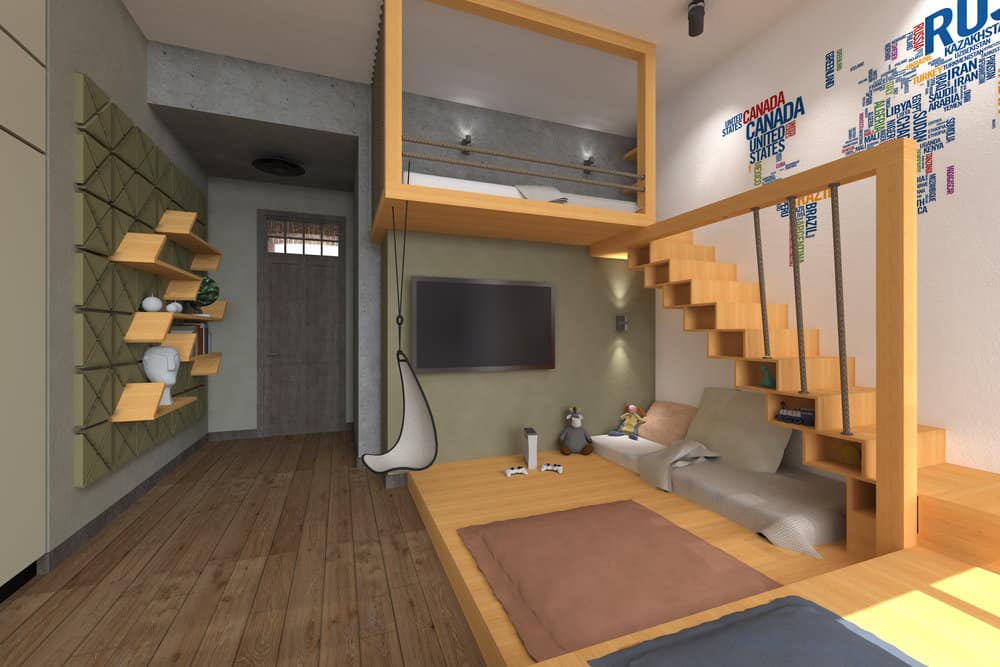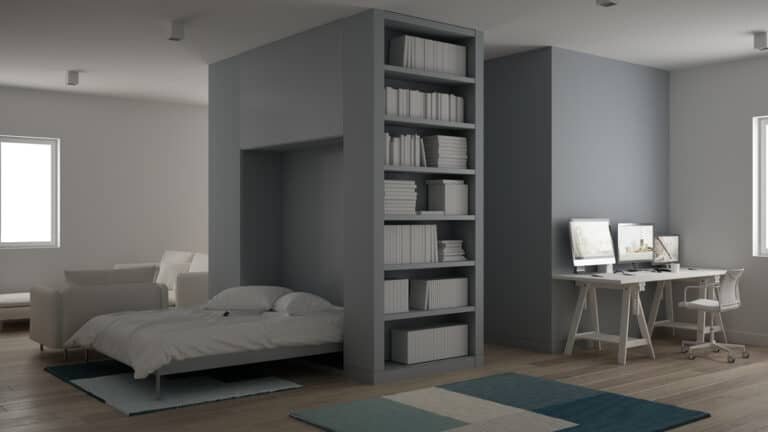Loft Bed Weight Limits: How Much Weight Can a Loft Bed Hold?
Homebody Forever is reader-supported. We may receive a commission if you make a purchase through a link on this post.
Loft Beds have become popular for those living in a small space, and I can completely understand why. They can do wonders when it comes to making a small room feel much bigger than it actually is.
But given their design, many people have questions about loft bed weight limits (and who can use them.) Should your bodyweight or the weight of your mattress affect your loft bed selection? Are manufacturers obligated to test a loft bed’s weight limitations and safety?
Keep reading to find the answers.

How much weight can a loft bed hold?
Most loft beds come with individual weight limitations. Before buying one, I’d suggest paying close attention to this and ensure that your bodyweight (and your sleeping companion’s), don’t exceed those limits.
The size and materials of the loft bed determine their weight capacity. A typical loft bed will hold 200 to 500 lbs (90 to 227 kgs) depending on whether it’s built for a child or an adult. You can also find a range of modern custom-designed loft beds that cater for heavier weights and larger mattresses.
Loft bed materials affect their weight capacity
Loft beds are typically made out of wood or metal. These are sturdy materials that tend to be superior to others.
Wood
If you decide to purchase a wooden loft bed, look for beds made with hardwood varieties such as Birch, Oak, Cherry, or Ash.
You can also opt for Pine Wood, although they do dent and scratch a little more. These hardwood varieties can support more weight than softwood ones.
Wood may expand in humid environments and shrink in drier climates. This can affect the stability of a loft bed over time as the bed joints can loosen, which can require additional maintenance.
Metal
Metal beds are great for supporting additional weight.
Select a loft bed with thicker poles if you need to support heavier sleepers or mattresses. Additionally, look for metal tubes that are solid rather than hollow, as they’ll be sturdier and more robust.
A wooden bed with metal support can also provide additional support for heavier weights.
When choosing the material, you might also want to consider the kind of decor you want for your loft bed.
Are loft beds tested to determine their weight limitations?
You may be a little surprised to learn that no universal weight testing standard exists for loft bed manufacturers.
Each manufacturer has its own standards for testing weight limits. They typically measure stress and strain capacity by applying pressure on various areas of the loft bed. Some manufacturers will also test weight capacity by placing a dead weight over the top of the loft bed.
Although the lack of universal testing may leave you less inclined to trust the safety of a loft bed, there are suitable, reliable ways to determine whether a loft bed will meet your weight requirements.
Bear in mind that when considering the weight your loft bed needs to support, always include the weight of the mattress, the person or people sleeping on the bed, and the weight of any bedding in your calculations.
How to calculate the weight of your mattress
I’m guessing that the size and type of mattress you own isn’t the first thing you think about when you want to buy a loft bed. But they should be.
Memory foam or quality latex mattresses can be substantially heavier than other mattress varieties (think air mattress or innerspring mattress.)
Waterbeds are the heaviest mattress variety and would definitely not be my top pick as a loft bed mattress.
To make things a little simpler for you, here is a breakdown of the most popular mattress options and their approximate weight, based on the size of mattress you’re interested in.
Innerspring Mattress
| Size | Approx. Weight Pounds | Approx. Weight Kilograms |
| Twin | 40 – 45 | 18 – 20 |
| Full Size | 50 – 60 | 22 – 27 |
| Queen | 120 – 160 | 54 – 72 |
| King | 130 – 180 | 58 – 81 |
Memory Foam Mattress
| Size | Approx. Weight Pounds | Approx. Weight Kilograms |
| Twin | 40 – 60 | 18 – 27 |
| Full Size | 55 – 80 | 24 – 36 |
| Queen | 80 – 160 | 36 – 72 |
| King | 100 -180 | 45 – 81 |
Latex Mattress
| Size | Approx. Weight Pounds | Approx. Weight Kilograms |
| Twin | 50 – 100 | 22 -45 |
| Full Size | 100 – 150 | 45 – 68 |
| Queen | 120 – 170 | 54 – 77 |
| King | 150 – 220 | 68 – 99 |
Water Mattress
| Size | Approx. Weight Pounds | Approx. Weight Kilograms |
| Twin | 1350 | 612 |
| Full Size | 1400 | 635 |
| Queen | 1500 | 680 |
| King | 1800 | 816 |
Air Mattress
| Size | Approx. Weight Pounds | Approx. Weight Kilograms |
| Twin | 8.5 | 3.8 |
| Full Size | 10.5 | 4.8 |
| Queen | 12.8 | 5.8 |
| King | 14 – 17 | 6 – 8 |
The denser or higher in weight, the more weight the mattress can support. Know your mattress weight specifications before ordering an online or custom-made loft bed.
Average loft bed weight limitations
Here’s a simple breakdown of the types of loft bed weight capacities.
These figures give you an idea of weight capacity by loft bed type and whether you may want to consider a custom bed option instead. Please always check weight limitations with your manufacturer before purchasing a loft bed.
| Loft Bed Market | Approx. Weight Limit (Lbs) | Approx. Weight Limit (Kgs) |
| Children | 150 – 200 | 68 – 90 |
| Adults | 250 – 500 / 600 | 113 – 226 / 272 |
| Custom High-Weight | 600 – 2000 | 272 – 907 |
| Adjustable Height | 220 | 100 |
Loft beds made for younger children are usually focused on quality and safety and are typically smaller and lower in height. They can usually carry approximately 150 to 200 pounds (68 to 90 kgs) of weight.
Regular adult loft beds are usually larger, sturdier, and made with durability in mind. They typically carry weights of approximately 250 to 500 pounds (113 to 272 kgs).
Adjustable height loft beds may initially seem like the answer, but remember that their flexible height locking mechanisms usually cannot support as much weight as solid wood or metal posts.
Purchasing loft beds from general markets
The general market loft bed weight capacity is typically around 200 to 250 pounds (90 to 113 kgs). Usually, you’ll struggle to find a loft bed that can support more than 250 pounds (113 kgs) unless you purchase from a custom manufacturer.
That’s because most loft beds you purchase from online and in-store furniture stores that are readily available are made with the general market in mind.
Purchasing loft beds from custom markets
If you are looking for a loft bed that will support higher weights than is readily available in the general market, you’ll need to approach the custom markets and manufacturers.
Custom loft beds can accommodate any weight and size mattress within reasons. Manufacturing a custom loft bed can be challenging and require additional materials and planning, so custom beds will be more expensive.
Custom loft beds designed with a queen, king, or California king bed mattress size are capable of holding weights of 1000 to 2000 pounds (454 to 907 kgs).
Keep in mind that the height of your loft bed doesn’t affect its weight limitations, and always request a quote before committing to a custom loft bed design and build. This way, you’ll avoid any nasty surprises when payment is due.
You may need to consider the size of your room as well. Here are some loft bed ideas if you have a low ceiling.
Final thoughts
Loft beds can support any weight requirement, but they may come with a price tag.
Before shopping around, verify the materials used and know the weight of the sleeper (or sleepers), mattress, and bedding. Taking the time to consider a bed’s quality, design, and safety will save you time and money in the long run.





